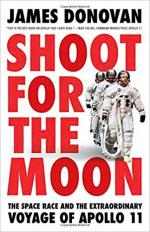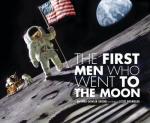August 5, 2019 | sobczakd
Neil Armstrong was born on this day, August 5. He would have been 89. On July 20, 1969, Neil Armstrong and Buzz Aldrin became the first men on the moon. It was back on May 25, 1961 that President Kennedy made a bold announcement before Congress to send an American safely to the moon and back before the end of the decade. At approximately 4:18 pm EDT, Neil Armstrong contacted NASA and said, "Houston, Tranquility Base here. The Eagle has landed." About 6 hours later, with more than a half billion people watching on their black-and-white tv sets, he climbed down the ladder from the lunar module and proclaimed, "That's one small step for a man, one giant leap for mankind." If you want to learn about this great man, here's some resources to get you started!
When the alarm went off forty thousand feet above the moon's surface, both astronauts looked down at the computer to see 1202 flashing on the readout. Neither of them knew what it meant, and time was running out...ON JULY 20, 1969, Neil Armstrong and Buzz Aldrin became the first humans to walk on the moon. One of the world's greatest technological achievements-and a triumph of American spirit and ingenuity-the Apollo 11 mission was a mammoth undertaking involving more than 410,000 men and women dedicated to winning the space race against the Soviets. Set amid the tensions of the Cold War and the upheavals of the sixties, and filled with first-person, behind-the-scenes details, Shoot for the Moon is a gripping account of the dangers, the challenges, and the sheer determination that defined not only Apollo 11, but also the Mercury and Gemini missions that came before it. From the shock of Sputnik and the heart-stopping final minutes of John Glenn's Mercury flight to the deadly whirligig of Gemini 8, the doomed Apollo 1 mission, and that perilous landing on the Sea of Tranquility-when the entire world held its breath while Armstrong and Aldrin battled computer alarms, low fuel, and other problems- James Donovan tells the whole story.
In 1961, President John F. Kennedy issued a challenge to the nation: land astronauts on the moon by the end of the decade. The Apollo program was designed by NASA to meet that challenge, and on July 16, 1969, Apollo 11 lifted off from Kennedy Space Center carrying astronauts Neil Armstrong, Michael Collins, and Edwin Aldrin. Apollo 11's prime mission objective: "Perform a manned lunar landing and return." Four days after take-off, the Lunar Module "Eagle," carrying Armstrong and Aldrin, separated from the Command Module "Columbia," and descended to the moon. Armstrong reported back to Houston's Command Center, "The Eagle has landed." America and the world watched in wonder and awe as a new chapter in space exploration opened. Through verse and informational text, author Rhonda Gowler Greene celebrates Apollo 11's historic moon landing.
In 1961, NASA test pilot Neil Armstrong is flying the X-15 rocket plane when it inadvertently bounces off the atmosphere. Although he manages to land the plane in the Mojave Desert, his colleagues express concern that his recent record of mishaps is due to distraction and he is grounded. His two-and-a-half year old daughter, Karen, is undergoing treatment for a brain tumor. Desperate to save her, Armstrong keeps a detailed log of her symptoms and feverishly tries to find possible treatments, but she dies soon afterwards. Grief-stricken, Armstrong applies for Project Gemini and is accepted to NASA Astronaut Group 2. Armstrong, his wife Janet, and their son Rick move to Houston alongside other astronaut families. Armstrong befriends Elliot See, another civilian test pilot, and Ed White. As Armstrong begins training, Deke Slayton impresses upon the new astronauts the importance of the Gemini program, as the Soviet Union had reached every milestone in the Space Race ahead of the United States. Armstrong and Janet have a second son, Mark. By 1965, the family has settled in Houston, and Armstrong awaits selection for a crew. After the Soviets complete the first extravehicular activity (EVA), Armstrong is informed that he will be the commander of Gemini 8, with David Scott as the pilot..
In the aftermath of a crushing family tragedy amid the pressing Space Race with the Soviet Union, the humble and quiet civilian test pilot, Neil Armstrong, is recruited by the chief of the NASA astronaut office, Deke Slayton, for the ambitious Project Gemini, in the dawn of 1960s. However, eight long years filled with trials, tragedies, but also, innovations will pass before Armstrong--as the commander of Apollo 11--along with the American astronaut, Buzz Aldrin, manage to land on the Moon the Apollo Lunar Module, Eagle, on July 20, 1969. On the arid and eerie lunar landscape dusted with powdery regolith, Neil takes the first step on the unknown celestial body, some 384,400 kilometres away from the Earth.
Well, you can believe some of it. There is some real history. But also hijinks. Time travel. And famous figures setting off on adventures that definitely never happened--till now. Time is getting twisted, and it's up to two kids to straighten things out. The students of Ms. Maybee's class used to think history was boring, but that was before time started to get twisted! When a spaceship carrying Neil Armstrong and Buzz Aldrin leaves 1969--and lands in 1869 Texas--cowboy Nat Love decides to trade in his horse for a trip to the moon. Can siblings Doc and Abby untwist history and get everyone back where they belong?Houston, we have a problem!
Comprised entirely of archival footage that’s never before been released to the public, Apollo 11, tells the story of the first moon landing as if it were a Hollywood thriller. There are no interviews with the subjects, no heavy-handed narration. There are only the sounds and images of the occasion—stunning and immediate, despite being a half-century old. A mostly electronic score pulses in the background, as the determined faces of Neil Armstrong, Buzz Aldrin, and Michael Collins fill the screen.
The unearthed footage is too mesmerizing, and the feat too incredible, for you to look away. It is a depiction of a wondrous human experience, told with startling clarity. It’s as close as any of us will ever get to that big gray rock floating far above our heads.
Director Todd Douglas Miller and archivist Stephen Slater worked with NASA and the US National Archives to unearth hundreds of hours of video (paywall) and thousands of hours of audio that they then had to match to the footage. (They also had to convert all of the film into a digital format.) Perhaps the only feat of mankind as painstaking and precise as launching three people to the moon is the act of turning all that footage into a coherent, exhilarating narrative.
It helps that the footage they found really is that remarkable. The accompanying audio, too, is a total treat, especially the radio communication between the astronauts and mission control back in Houston, Texas. (One particular gem is a radio communicator recording the three astronauts’ heart rates during the launch sequence. Collins and Armstrong’s were both well over 100, as you’d expect. Aldrin’s was 86—pretty much a normal resting rate.)
Apollo 11 comes shortly after another documentary that makes great use of archival footage—Peter Jackson’s World War I doc They Shall Not Grow Old. Jackson and his team sifted through 600 hours of videofrom the Imperial War Museums in England and audio from the BBC archives, before restoring, colorizing, and converting it to digital. Jackson also hired lip readers to decipher what the soldiers in the footage were saying, and voice actors to act their words out.
Neither the 1969 moon landing nor World War I are mysteries to the general public, but these two documentaries both fill in gaps in the emotional stories, using faces, voices, and personal accounts to add to our understanding of these historic moments. History is not finished when you learn what happened. We should also unravel, as best we can, what it was like to be there. In under two hours, Apollo 11 takes us to the moon and back.
In 1969, humankind set foot on the moon. Neil Armstrong, Edwin "Buzz" Aldrin, and Michael Collins carried the fire for all the world. Backed by the brightest minds in engineering and science, the three boarded a rocket and flew through the void--just to know that we could. In Apollo, Matt Fitch, Chris Baker, and Mike Collins unpack the urban legends, the gossip, and the speculation to reveal a remarkable true story about life, death, dreams, and the reality of humanity's greatest exploratory achievement.
On July 20, 1969, Neil Armstrong stepped on the moon and, to an audience of over 450 million people, proclaimed his step a "giant leap for mankind." This Eagle Scout built his own model planes as a little boy and then grew up to be a test pilot for experimental aircraft before becoming an astronaut. Over 80 black-and-white illustrations bring Armstrong's story to life.







